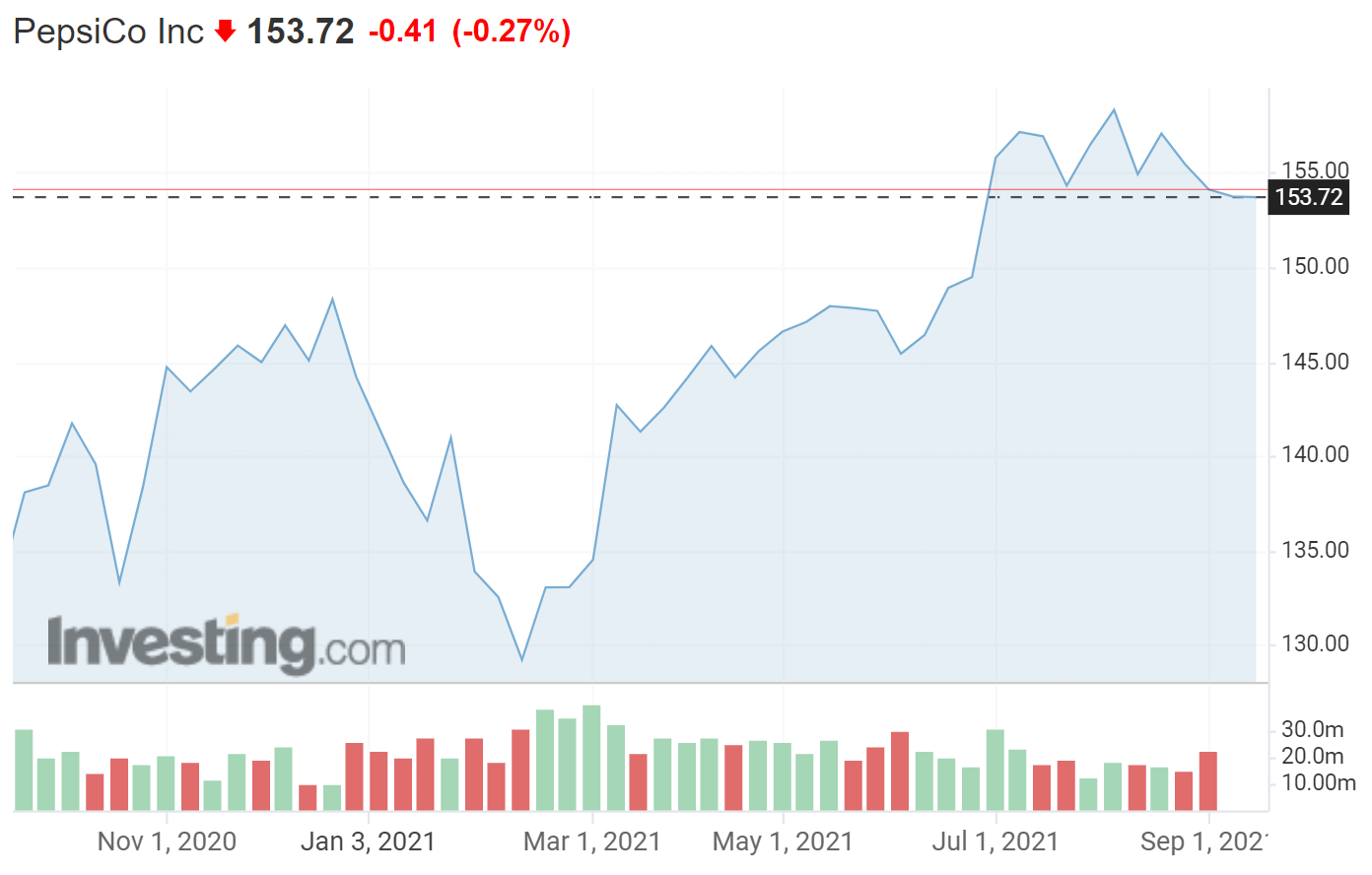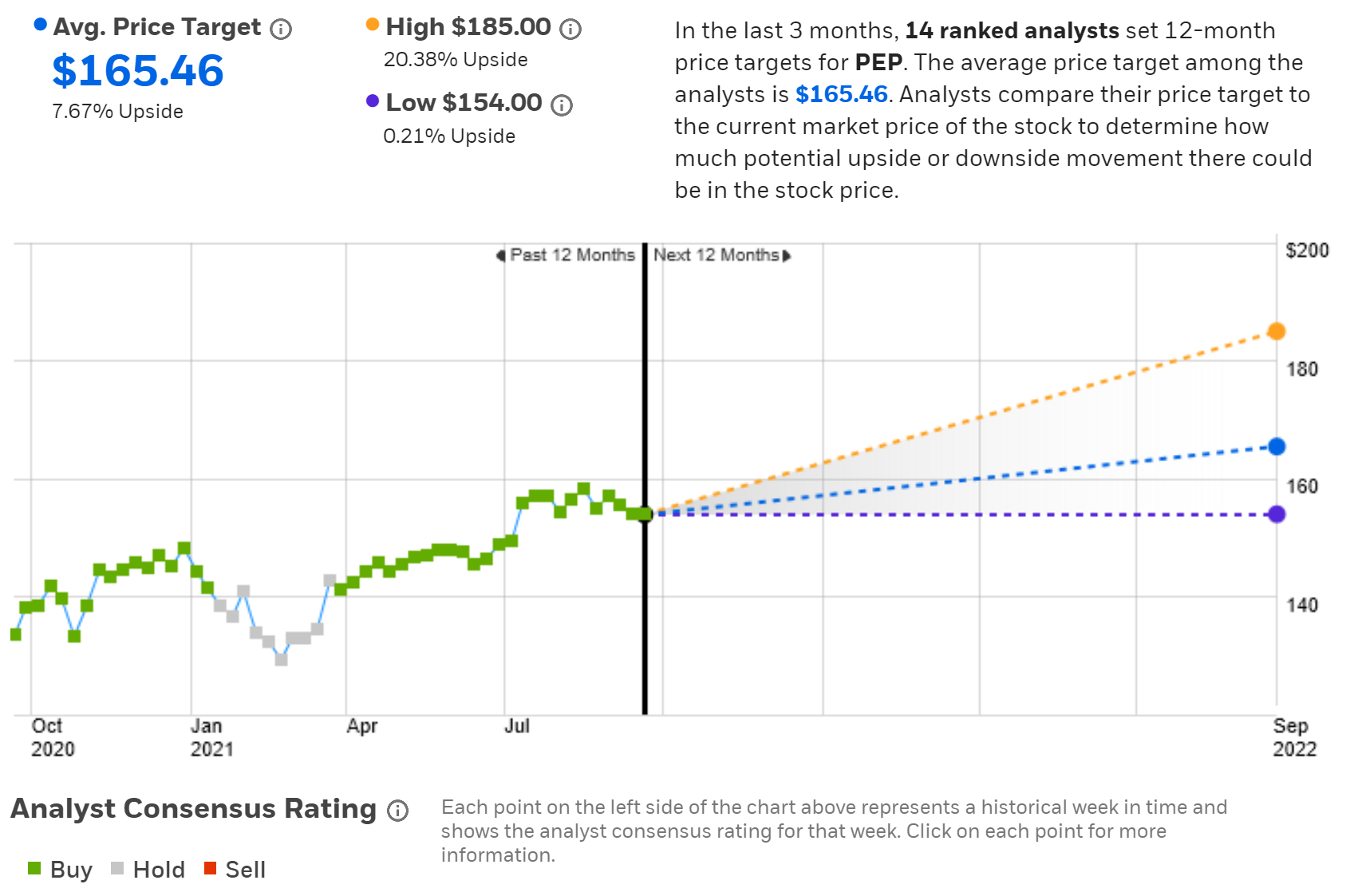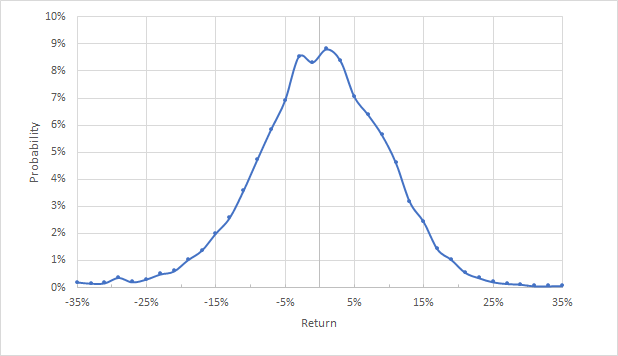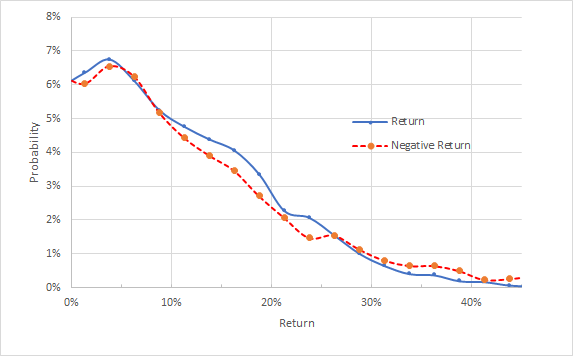Although shares in PepsiCo (NASDAQ:PEP) have not moved much so far in 2021, with a year to date total return of 6.07%, the Pepsi, Gatorade and Doritos seller is still worth a closer look.
The food and beverage behemoth reported strong Q2 results on July 13, beating the consensus expected EPS by 12.3%. Despite this strong performance, its longer-term returns are considerably below those of the overall equity market.
But the investment narrative for PepsiCo is not about high return on a standalone basis. Its 5-year beta of 0.6 and 49 years of continuously-increasing dividends means PEP provides portfolio stability that can buffer some of the risks associated with growth stocks. Low-beta stocks have portfolio benefits that offset their lower individual returns.

Source: Investing.com
I am concerned that low-beta stocks may have a structural headwind as index investing represents an ever-larger influence. As the market rises, a low beta stock in an index tends to increase less than a high beta stock. Therefore new dollars flowing into market-cap weighted index funds will be allocated more heavily to the higher-beta stocks than the lower-beta stocks. This process has the potential to suppress investment in lower-beta names over time.
The dividend yield is 2.79% and the trailing 5-year and 10-year dividend growth rates are 7.59% and 7.74%, respectively. Using the Gordon Growth Model, one might expect total returns of around 10.5%, which is in line with the total returns over the past 3-15 years. The P/E (TTM PE is 26.1 and forward PE is 23) is quite high relative to historical values, but equities can sustain higher P/E ratios when interest rates are lower (because low interest rates correspond to a lower discount rate applied to projected future earnings).
Along with the fundamentals, I look at two forms of consensus outlooks in evaluating a stock. The first is the well-known Wall Street analyst consensus. The analyst consensus price target has meaningful predictive value, as long as the dispersion between the analysts is not too high.
The second form of consensus outlook that I consider is derived from the prices of options on a stock. The price of an option represents the market’s consensus estimate of the probability that the stock price will rise above (call option) or fall below (put option) a specific level (the strike price) between now and when the option expires. By analyzing call and put options at a range of strikes and a common expiration date, it is possible to calculate the probabilities of all possible future returns between now and the expiration date that will reconcile the options prices.
This is the market-implied outlook, representing the consensus view from buyers and sellers of options. For those who are unfamiliar with the market-implied outlook, I have written an overview post, including links to the relevant financial literature.
Wall Street Consensus Outlook for PEP
eTrade’s calculation of Wall Street analyst consensus includes the view of 14 ranked analysts who have issued price targets and ratings for PEP within the past 90 days. The consensus rating is bullish and the consensus 12-month price target is 7.7% above the current level. This is very close to the 5- and 10-year dividend growth rates, consistent with the Gordon Growth model. The lowest of the analyst price targets is very close to the current price. Of the 14 analysts included in the consensus, 7 are bullish and 7 are neutral on PEP.

Source: eTrade
Investing.com calculates the Wall Street consensus by combining the ratings and price targets of 22 analysts. The consensus rating is bullish and the consensus price target is almost identical to eTrade’s value, implying expected 12-month price appreciation of +7.5%.

Source: Investing.com
The Wall Street consensus is bullish, with a 12-month price target that is in line with the longer-term dividend growth rate. Combined with the dividend, the consensus for total return is 10.2%. This total return is very close to PEP’s annualized 5-year total return and slightly below the 3- and 10-year values. For PEP to be an attractive buy, the expected volatility needs to be low enough to make the risk/return balance attractive.
Market-Implied Outlook for PEP
I have analyzed call and put options at a range of strike prices, all expiring on Jan. 21, 2022, to build the market-implied outlook for the next 4 months. I have also calculated the market-implied outlook for the next 8.8 months using options that expire on June 17, 2022. I chose these two expiration dates because they provide into early 2022 and to the middle of 2022. In addition, options expiring in January and June tend to be liquid, adding confidence in the market-implied outlook as a measure of the consensus view.
The standard presentation of the market-implied outlook is in the form of a probability distribution of price return, with probability on the vertical axis and return on the horizontal.

Source: Author’s calculations using options quotes from eTrade
The market-implied outlook for the next four months, into January 2022, has similar probabilities for positive and negative returns of the same magnitude. The peak probabilities are generally centered near zero, and the absolute maximum probability corresponds to a price return of +1%. The annualized volatility derived from this distribution is 21.3%.
To make it easier to directly compare the probabilities of positive and negative returns, I look at a version of the market-implied outlook with the negative return side of the distribution rotated about the vertical axis (see chart below).

Source: Author’s calculations using options quotes from eTrade. The negative return side of the distribution has been rotated about the vertical axis.
This view shows that the probabilities for positive returns are consistently higher than for negative returns (the solid blue line is above the dashed red line) for a wide range of the most probable outcomes. This tilt towards positive returns is a bullish indicator from the options market. Theoretically, the market-implied outlook is expected to have a negative bias because risk-averse investors will pay more than fair value for put options to limit losses. Dividend-paying stocks also tend to have a negative tilt because dividend payments reduce the potential price appreciation relative to potential declines. Considering both of these factors, this market-implied outlook is mildly bullish.
Looking out 8.8 months (using options expiring on June 17, 2022), the market-implied outlook is similar to the 4-month outlook. The peak probability corresponds to a price return of 3.75%, but the peak in probability is not significantly higher than for a negative return of the same magnitude because of the secondary peak in probability. The annualized volatility calculated from this distribution is 20.7%. The 8.8-month market-implied outlook is mildly bullish.

Source: Author’s calculations using options quotes from eTrade. The negative return side of the distribution has been rotated about the vertical axis.
The market-implied outlooks calculated for PEP provide a consistent picture. The options market shows probabilities of positive returns that are modestly but consistently higher than for similar-magnitude negative returns. The expected volatility is about 21%. This market-implied outlook is mildly bullish for both the 4- and 8.8-month periods.
Summary
Stocks like PEP, the consistent long-term growers, deserve an allocation in most portfolios. The stock’s low beta means that it will lag in rising markets, but will also buffer losses in down markets. In current market conditions, with trailing 5-year annualized returns for the S&P 500 of almost 18% per year, many investors ignore stocks like PEP.
Over extended periods, an allocation to PEP, a low-beta stock with a 10% expected total return, is likely to increase an equity portfolio’s risk-adjusted return. As a rule of thumb for a buy, I want to see an expected 12-month return that is at least ½ the magnitude of the expected volatility.
Using this metric, PEP is right on the cutoff (expected total return of 10.2% from the analyst consensus and expected volatility of 21%). The portfolio benefits of low beta stocks should count as an additional plus for PEP, however. The market-implied outlook for PEP is mildly bullish, as well. Overall, I am slightly bullish on PEP.
